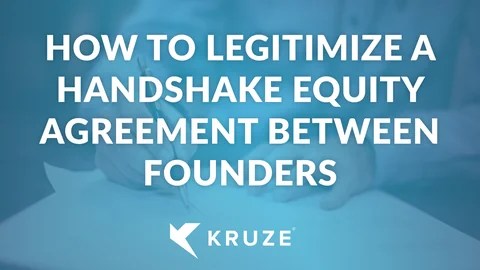
Startup founders often ask us how to legitimize a handshake equity agreement between two founders. This is a great question and often comes up around equity grants. When it comes to the ownership of the company, what happens a lot of times, one of the founders incorporates the company and he or she is recruiting the business or the technical founder and promises them a certain amount of equity. However, that can go on for a long time and it’s in the best interest of the company and everyone involved to formalize and legitimize that agreement so that there are no misunderstandings. This also helps protect the company and team.
When should founders legitimize a handshake equity agreement?
It’s important to legitimize a handshake equity agreement as early as possible because as startups start to grow, the valuation or value of the startup goes up. When you are forming those agreements and the stock agreements, you want to issue stock at as low a price as possible so that there’s the most upside and so that your co-founder has a lot of upsides and can pay less in taxes.
So I recommend people do this as soon as the agreement is reached. I don’t like the handshake agreements that go for three or six months or even a year. It can breed a lot of insecurity and it can have financial ramifications for everybody.
You should hire a lawyer when legitimizing a handshake equity agreement.
So the way you are going to do it is, you are going to hire a good lawyer. That’s right, a good lawyer is inexpensive and will save you a ton of time and make sure it’s done properly. At Kruze we’ve got a ton of good lawyers we work with if you need a referral. And that lawyer is going to put together what’s called a founder share agreement or grant. And that’s going to be spelled out exactly how many shares the co-founder gets, basically the percentage value of the company. And it’s not that long of a document, but it also protects the company and it’s also going to spell out vesting periods. Typically, founder shares can also be vested. So you’ll vest over four years and you’ll have a one-year cliff, meaning you don’t get any of it until you pass the one-year mark and then you start vesting every month. But the cool thing about founder shares is that they can be purchased in advance even if you haven’t vested all of them. And that allows you to lock in that very, very low price.
Also, certify mail the 83(b) form when you send it to the IRS.
You have 30 days to file an 83(b) from the date the paperwork goes into effect. Please don’t forget to do this. You will want to certify mail the forms when you send them to the IRS because this way, you will have proof you did it. And that means that you can lock in that low-cost basis and all appreciation after it is taxed at a capital gains rate which is much lower than the general income rate. You can read more about when to file an 83(b) election here.
PROTIP: The co-founder should absolutely sign an IP assignment as part of this so there is no IP that the company doesn’t own.
The company is protected because you are also going to have the co-founder sign an IP Assignment Agreement meaning all the technology they’ve built while they didn’t have this agreement formalized is going to be incorporated into the company’s IP.
That way, when you go to get bought in three or four years nothing weird happens where the company does not own some of the IP that the co-founder created before he or she was working with the company. To recap, legitimize the equity agreement as soon as possible. It is in everyone’s best interest. Certify mail your forms to the IRS. Make sure you have a good lawyer. The lawyer’s going to know to have the IP assignment signed. The lawyer is going to know how to have the founder agreement drawn up correctly.
And again, it’s just, it may be cheaper if you work with someone really good who does this all day long.
How to manage your equity
Once you have your equity arrangement solidified from a legal point of view, you now have what’s called a “capitalization table” or a “cap table.” Basically, this is a chart/table that shows who owns what % of the company. If the company is just you and another cofounder (or two), keeping track of who owns what is pretty simple. However, as you take on outside investors or as you offer stock options to employees, or if you start to give warrants or other equity incentives to advisors, the complexity of managing your cap table goes up dramatically. At that point, you should pay for a cap table management software. It’s worth it to avoid the headache of confusion about who owns what!















